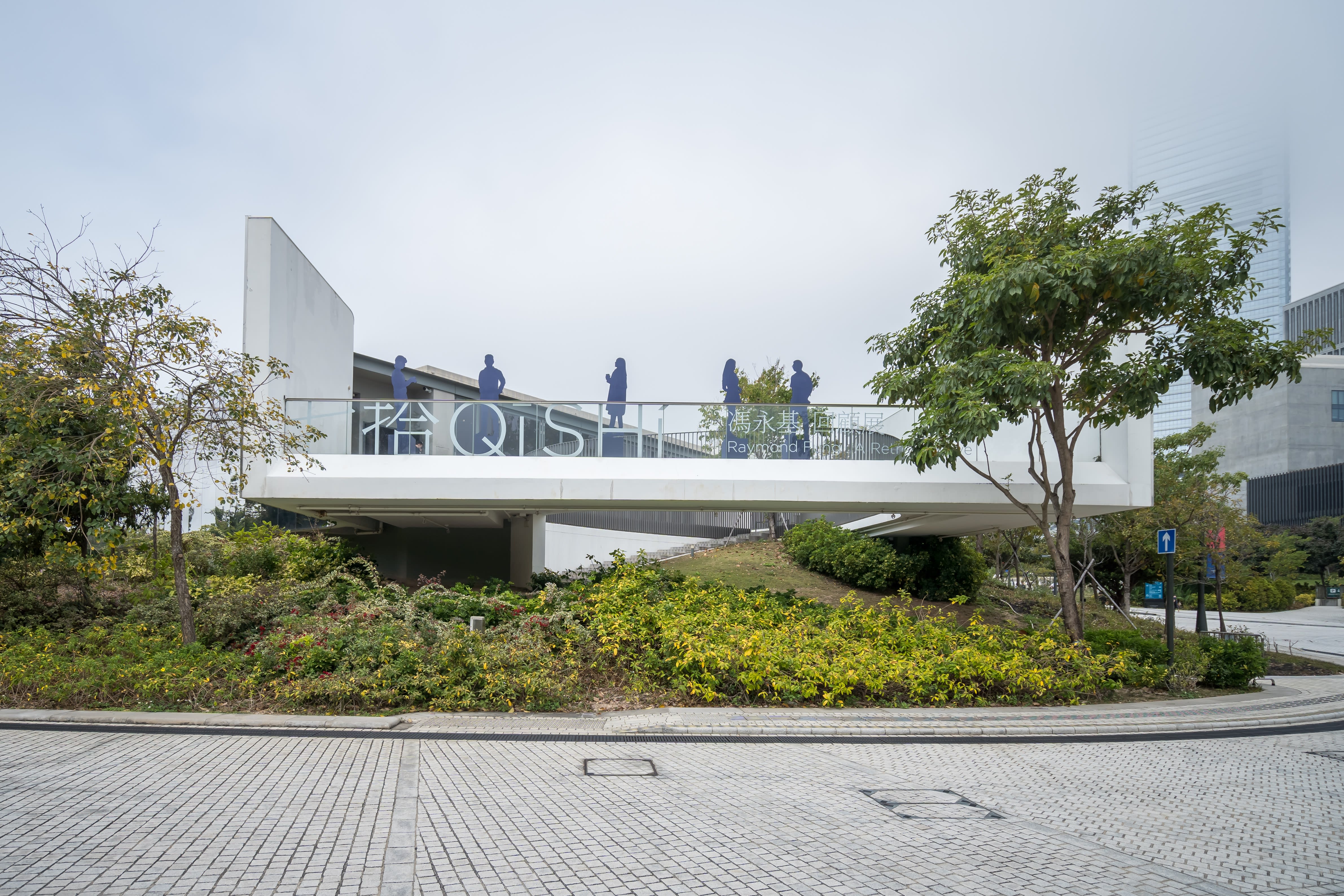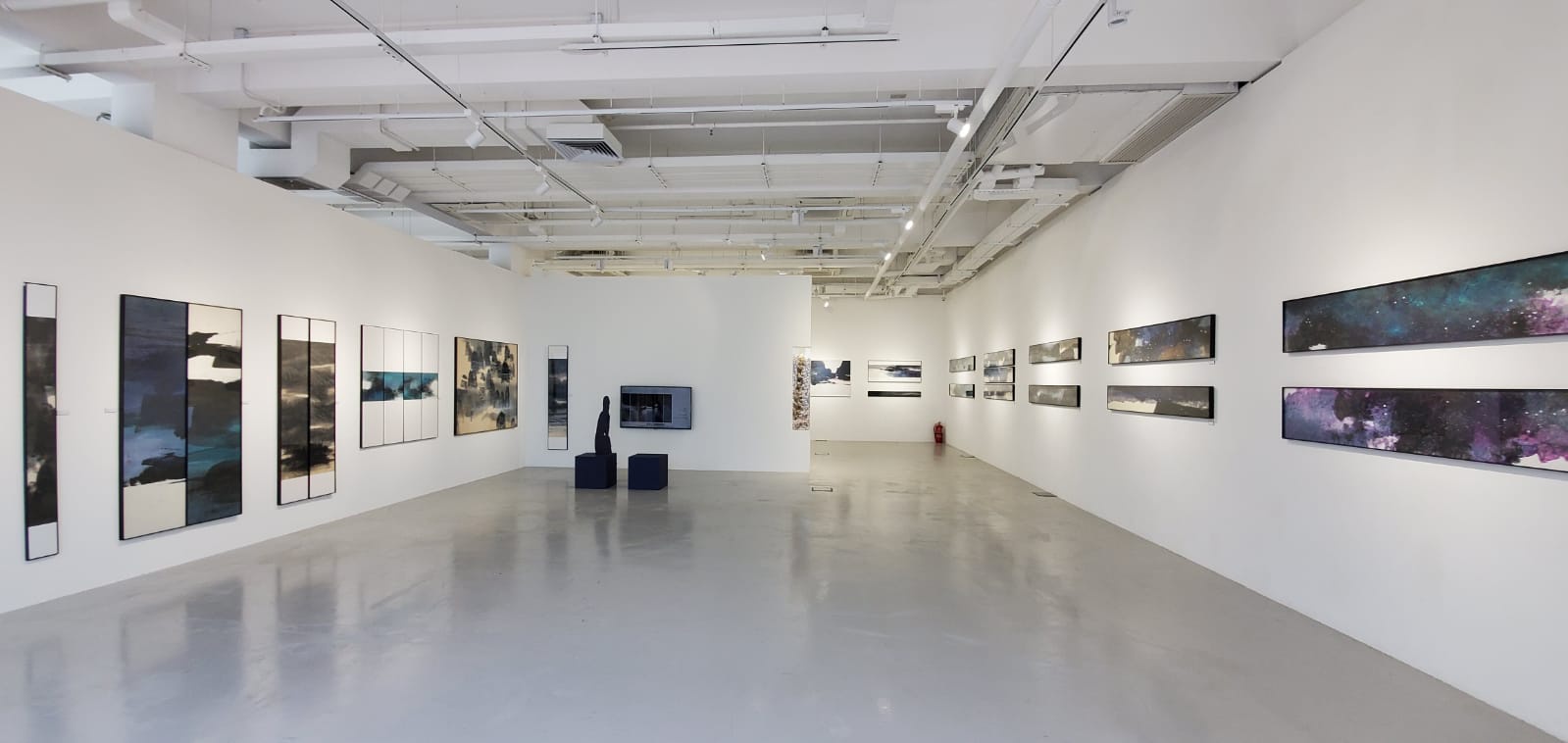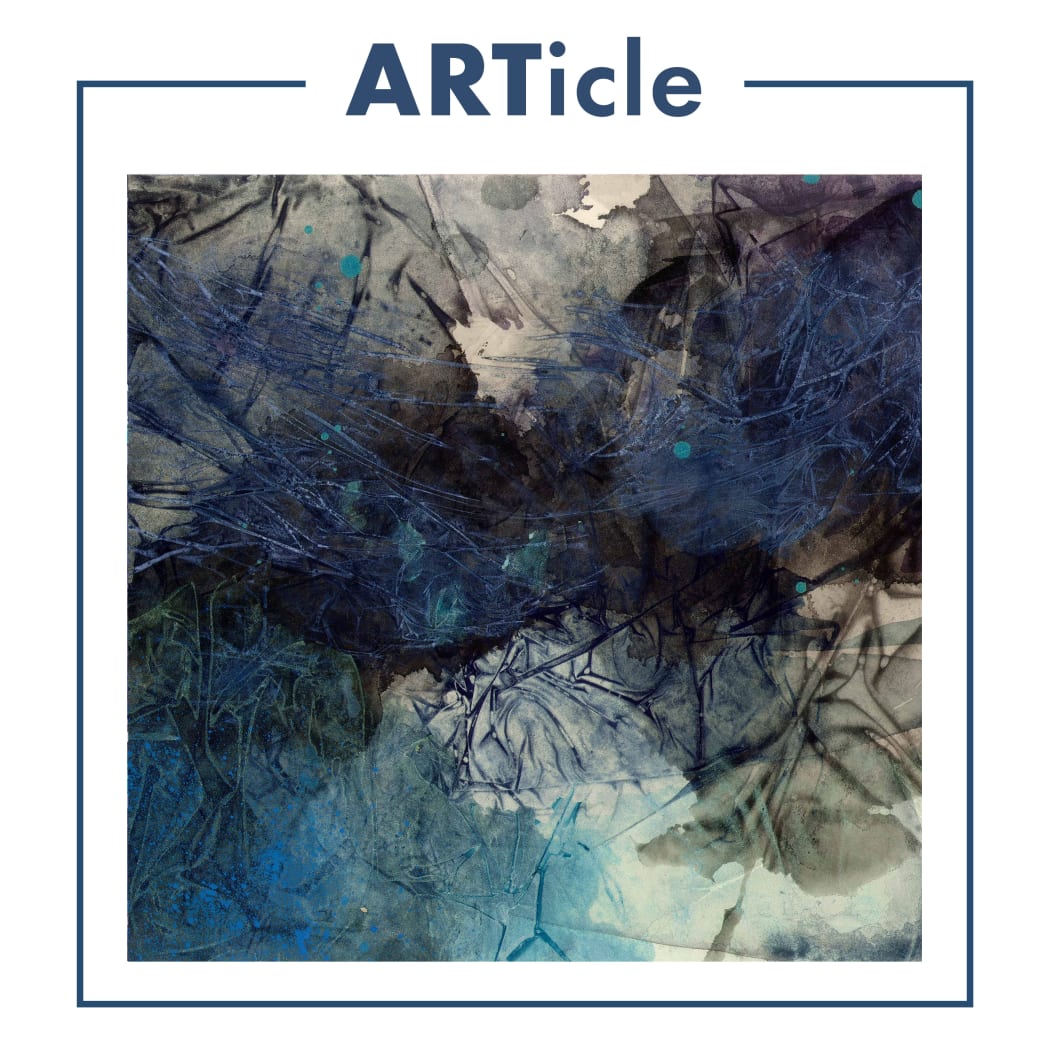
Exhibition 'Qi Shi' Installation View
'FUNG DOES NOT DEPICT LANDSCAPES SO MUCH AS THE EMOTIONAL ESSENCE OF THE LAND'
In this retrospective exhibition of the distinguished architect and artist Professor Raymond Fung marking seven decades of his life, a wide range of works are brought together for the first time tracing his evolution as an artist since the 1980s. At the age of 9, Fung first sketched his home city, Hong Kong. This early line-drawing [FIG 1] shows a meticulous attention to detail in his careful tracing of the city, indicating the artist’s early architectural instinct and sense of place.
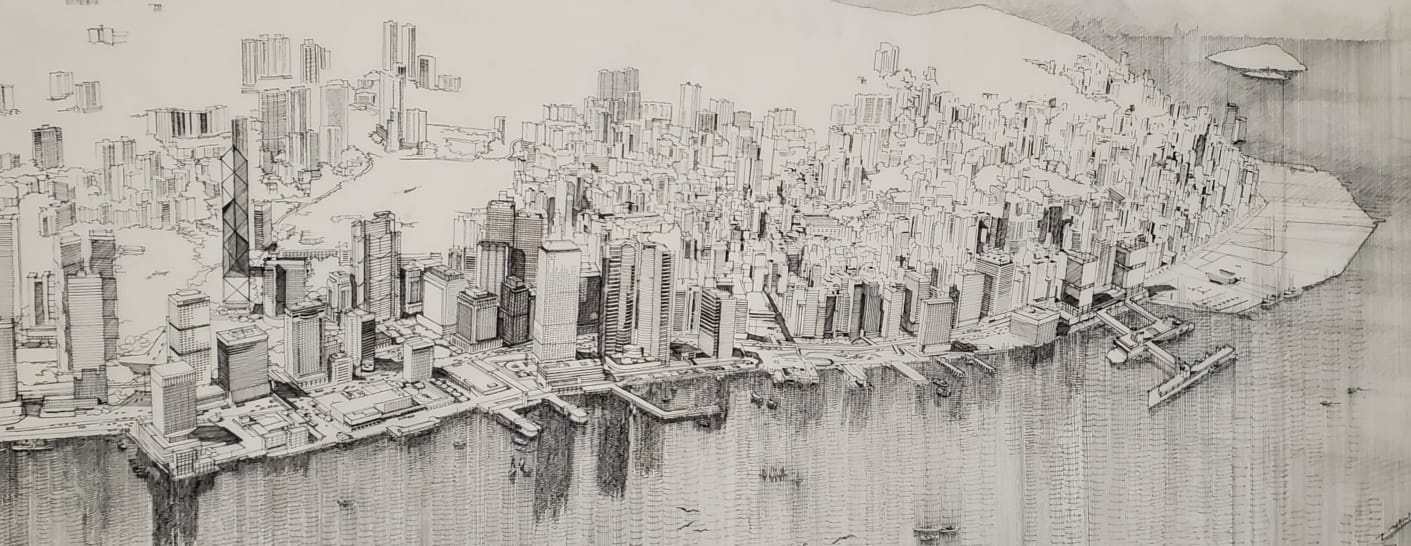
Fig 1: Island North, 1985, Rapidograph print on tracing paper, 55 x 100 cm
In his later artistic practice, these lines would dissolve completely in favour of broad liquid brushstrokes that allow the ink to seep naturally in huge expanses. Carefully balancing space and volume, solid and void Fung has developed his own contemporary engagement with the lineage of ink painting in the modern period. These works that activate landscapes are both real and imaginary. In many of his works, the contours of the land and islands of Hong Kong are referenced in the painterly sweeps of ink. Then, in a kind of magical transformation, they are rendered timeless and universal as landscapes belonging not to a single place but to the spiritual dimension of the cosmos in the spirit and style of the Chinese poetic and philosophical tradition.
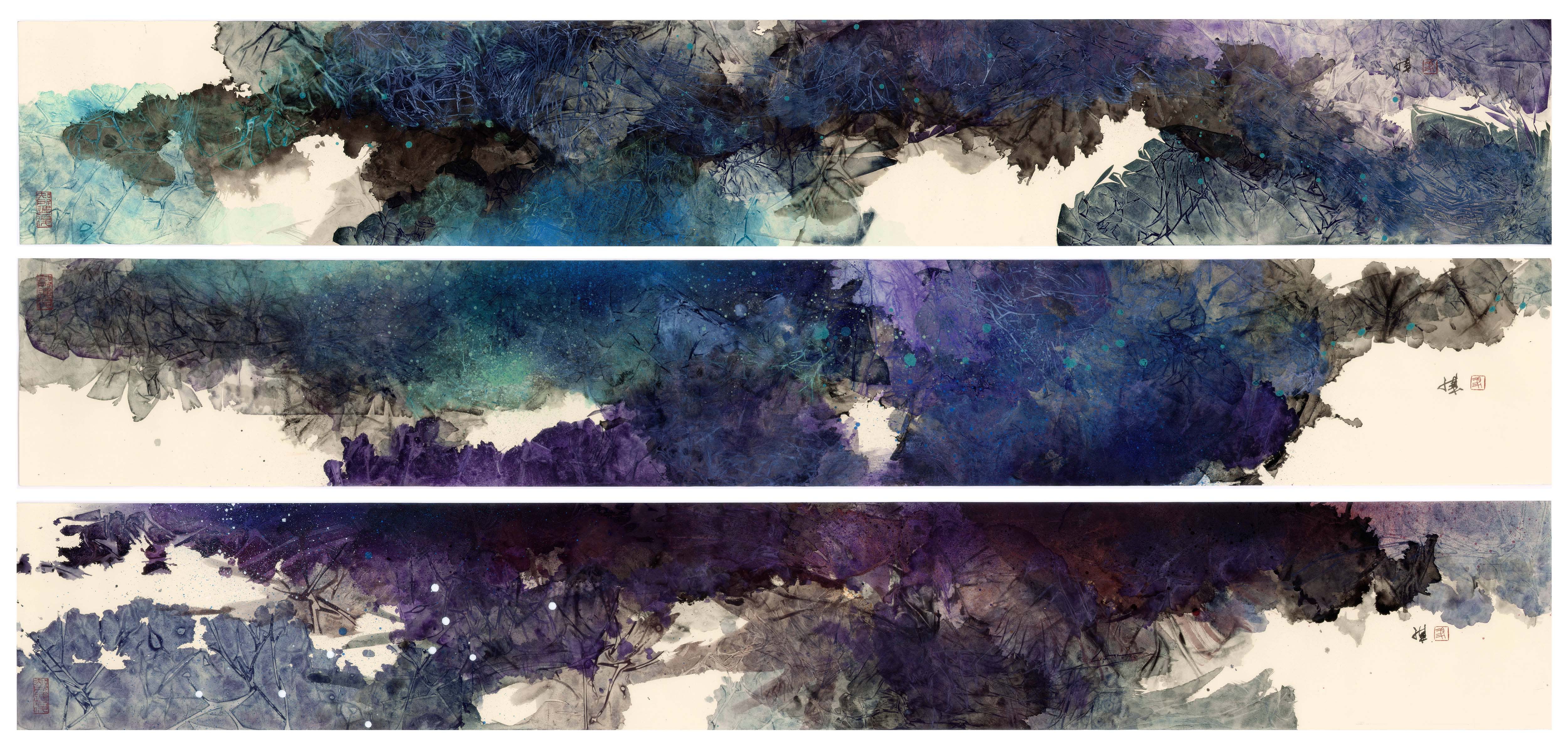
Breathing (24)(25)(26) , 2021, Ink and colour on paper, 26 x 180 cm
Operating within the language of contemporary Chinese abstraction that has evolved since the 1950s in East Asia, Fung’s work incorporates elements of modernism, post-war painterly abstraction and the gestural freedom of ink in the expanded field that has taken off in the past two decades in the region. Pioneering groups of Chinese abstraction were the Fifth Moon group in Taiwan from the mid-1950s and in Hong Kong, the New Ink Movement led by Lui Shou Kwan: ‘the movement gained unprecedented momentum in the 60s and 70s, marking an important milestone in Hong Kong’s modern art history.’2 In this context, global and local art histories come into play in the reading of Fung’s works, when we consider the interplay between the metropolitan centres in East Asia, such as Hong Kong, Shanghai, Tokyo and Taipei, and the transnational developments of global abstraction in the post-war period, added to Fung’s training as an architect in the USA in the 1970s.
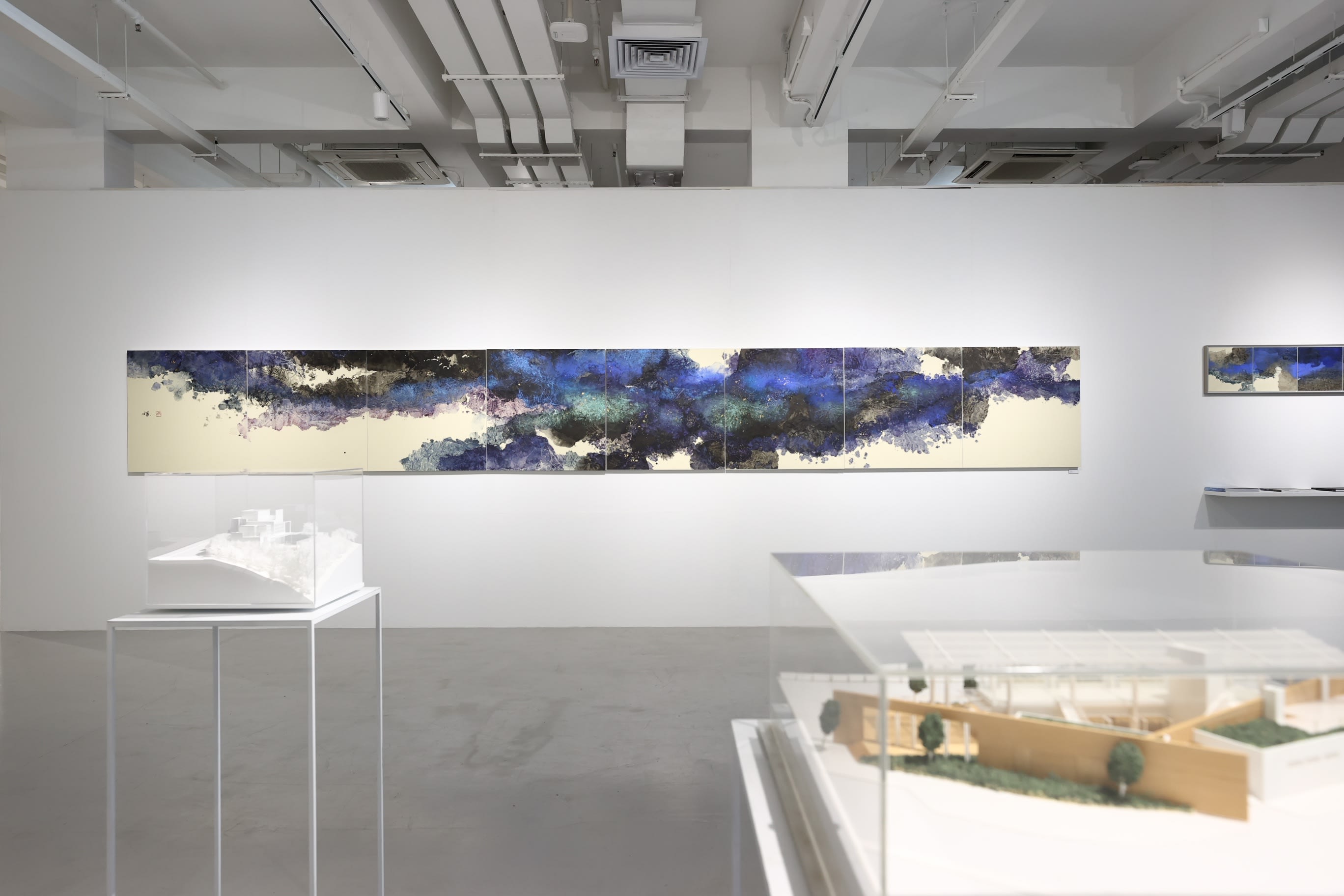
Our Land, 2021, Ink and colour on paper, 90 x 90 cm x 8
Born in Hong Kong in the early 1950s, the life of Raymond Fung spans the decades of the city’s post-war history. This is a fascinating history encompassing the intense development of an international city that became a key trading hub under British colonial rule leading up to the post-colonial 21st century metropolis of today. Made up of a heady mix of sleek high-rise and large-scale housing projects, old tenement buildings, densely packed streets of shops and restaurants, the fast-paced business world and new developments contrast architecturally with the higgledy-piggledy steep lanes of old Hong Kong with its rich and wonderful tropical foliage, filled with cafes, bars, boutiques and small cultural spaces. Beyond these contrasts, nature has endured as a constant presence in Hong Kong’s scenery, and this is visible in Fung’s works of ethereal beauty, evoking the bays and vistas beyond the densely packed city space explored from a deeply personal standpoint.
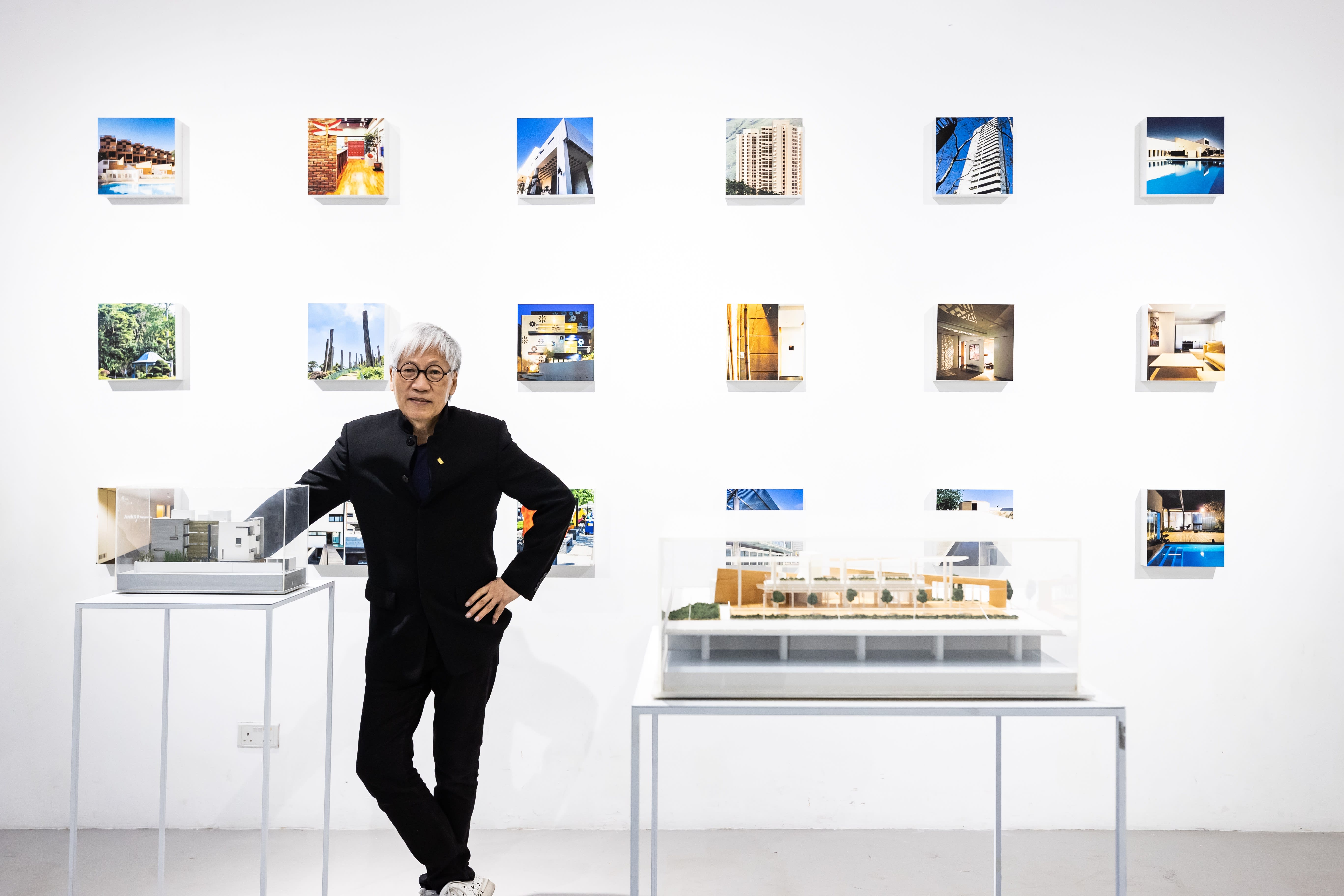
Raymond and his architectural projetcs showcased in 'Qi Shi'
The exhibition’s concept of 70 years (七拾) can be read as a conscious recollection of Fung’s achievement, implicit in the word ‘shi’ 拾 in its title, with its connotations of ‘picking up’ or collecting.3 Fung’s contribution as a professor and role model to the younger generation and as a cultural producer juggling numerous creative roles as artist and civic architect should also be noted in a retrospective that nevertheless can be seen as also looking ahead in his commitment to an enduring legacy. From the 1980s onwards, it is possible to track Fung’s artistic evolution. From the smaller works exploring technique through a variety of figurative subject-matter such as bamboo, mountainous scenes or a kitten, to his longstanding development of abstract landscape forms, the lineage of Chinese ink painting is expanded into new expressive poetic interpretations that have been honed and refined in the past twenty years. Works exploring a new form of abstraction in the 1980s, show an inclination for forceful thick black lines cutting across the space set off by patches of pinks or oranges that light up the monotone, in a distinctly Hong Kong modern aesthetic developed by twentieth century painters such as Lui Shou Kwan (1919-1975). Lui held his first exhibition in Hong Kong in 1954, pioneering a unique form of vibrant abstraction in his innovative use of ink, an influence acknowledged by Fung. Lui’s Zen paintings from the 1970s are stunning examples of radical Chinese modernism, combining huge energetic brushstrokes and daubs of red in minimalist, exuberant compositions that are aesthetically unique. Fung’s homage to this lineage is visible in his vibrant, vast splashes of ink and the use of colour and gold to create touches of brilliance.

Beyond Horizon, 1984, Ink and colour on paper, 59 x 62 cm
When Fung was a child, mass immigration caused huge housing challenges on the small landmass on which a rapidly increasing population was squeezed into vertical buildings now accommodating over seven million people. In the aftermath of WWII, the population grew from a mere 600,000 to one of 2.5 million within ten years, as hundreds of thousands poured over from the mainland to search for a new life, existing on almost nothing in fragile self-built shanty towns. The metropolis of today is a heady mix of all the elements accumulating in an intense environment that more recently has gained an expanded art scene of galleries, the renovated Hong Kong Museum of Art and the new cultural district of West Kowloon with its flagship building of M+ Museum, the smaller pavilion of which will host Fung’s smaller retrospective exhibition. This dramatic architectural space will allow a more experimental side of Fung’s practice as a contemporary artist, with the visually exciting installation made up of the roof tiles from the Flagstaff House Museum of Teaware and a ping pong table, signifying his own passion for the game but also perhaps his agility in working across disciplines and media. These two elements are brought into play to connect the architectural legacy of the colonial era with the joyful social activities of the day-to-day. Cutting through the exterior wall of the pavilion to spill outside it, the installation connects the interior with the exterior, as central aspects of Fung’s life and work.

Exhibition 'Qi Shi' Installation View
As a local resident and a cultural leader deeply invested in the life and culture of Hong Kong, Fung forges a type of modernism intrinsic to the city’s history, as a space where the international has always collided with the local. A global metropolis that has for decades acted as a major economic hub in Asia, Hong Kong has nevertheless retained the paradox of its local culture staying close to its roots, exemplified by the fact that very few Hong Kong architects are known globally and its artists are only recently being acknowledged in the art world within the international context. 4

Hollywood Road, where Raymond Fung grew up in the 1950; Fan Ho, photograph of HK in the 1950s.
Fung’s biography is full of fascinating details by his own account: the absence of his father, and the apocryphal story of his leaving to ‘sell salted duck eggs’ is a wonderful evocation of an occupation so telling of the world of 1950s’ Hong Kong. This story, according to Fung, ‘was the model answer taught by my mum for answering people’s questions when I was small.’5 In this small personal detail, a range of social issues can be read between the lines, of a single mother fending off inquisitive neighbours, the need to survive socially as well as economically, and the perception of a small boy intrinsically understanding these nuanced social sensitivities. In a lively account of the street culture in Hong Kong, Fung recalls how, ‘At four o’clock every day, I liked going to the Possession Point Flea Market to see the performance of a hawker using grilled hot maltose to draw dragons.’6 Referred to in his childhood as ‘B’, his elder sister ‘A’, there is a highly pragmatic itemised labelling of the children characteristic of an unsentimental need to avoid personal attachment in order to survive harsh circumstances. B (Raymond) was born in the year of the Dragon, leading to inevitable parental expectation of high achievement as a child due to this special year of birth, which later came to be. Playing down his lack of academic prowess, there was clearly outstanding talent emerging through his early drawings regularly sent in to win competitions.
Yet, right up to the early 1990s, Hong Kong was a not a city that appreciated artistic culture – after all, in a situation of economic survival, what use is a painting? In the early days of galleries such as Alisan Fine Arts, co-founded by Alice King in the 1980s, buyers would ask for paintings that matched the furniture in a highly functional approach to culture and art.7 Fung’s pursuit of painting lies in parallel with the city’s cultural expansion and maturation, delineated by important landmarks such the building of the Hong Kong Arts Centre designed by Fung’s mentor Tao Ho in the 1970s.

Raymond and Our Land (2021)
Fung’s ink painting is highly individualistic, as contemporary works responding to place and cultural contexts, but also to the long lineage of the refined poetic tradition. Horizontal and vertical spatial dynamics are expanded and emphasized echoing key tenets of the Chinese landscape genre. Breaking through conventions of the shanshui tradition, with its constant slow shifts over a thousand years since the Song dynasty (960–1279), Fung’s individual style contains legacies that he acknowledges such as the revered Ming master Shi Tao (1642-1707) and the modern painter Zhang Daqian (1899-1903), known for his flamboyant experimentation with the medium and expansive interpretation of landscape through splashes of colour and sweeping use of abstraction.

18 Shades in Ink series, 2018, Ink and colour on paper, 136 x 280cm
Fung’s paintings are organised in elongated scroll formats, both vertical and horizontal. In his vertical series, the horizontal viewpoint is cut through, allowing a spatial arrangement through which uncluttered pictorial compositions can be seen as both a continuous whole and as a series of glances. His work is minimalist, abstract and uncluttered, yet exudes a poetic sensibility that is also impassioned and eloquent. The details within it are rich and varied, as the use of textures, flecks and tones can be discerned, drawing the viewer into a more intricate world that can be tracked through the tones, cracks and saturation of the ink, carefully fused in different tonalities of colour and depth. Crunched up paper is manipulated to create depth of field and fissures, in a technique used by many painters in the contemporary period such as Liu Guosong, who was at the forefront of Chinese modernism in the 1950s and 1960s.

Exhibition 'Qi Shi' Installation View
The works on display in the exhibition belie the complex ways that they are produced, in a technical feat that involves a carefully managed tension between control and release, requiring enormous skill in the use of the brush and the level of absorbency of ink on the paper. Fung mentions that he learned about the need for solid and void and later transferred the principle into paintings. Just as tools are used by oil painters to create texture and surface effects, ink painters also experiment with ways to push the medium further. In his 2020 ‘Life’ series, executed during the Covid-19 pandemic, crinkles are created using clingfilm, paper is scrunched up, the ink is massaged in to blend areas together, to achieve the textural qualities of the leaves. In this series, as mentioned in his 3812 Gallery exhibition catalogue, his concern for broader themes of life, breath and the environment have come to the fore. His conscious examination of nature also echoes the Lingnan School painters’ as evident in the works of the Lingnan master, Yang Shanshen.
The topography and terrain of ink: ‘being black or being white, being empty or being full’
Hong Kong as a context for ink painting in the post-war period informs Fung’s work geographically and aesthetically. Comprising a dense built environment with the culture of a coastal area full of small islands and bays, these features also inform its modern artistic development. Innovative ink painters with strong personal styles such as Lui Shou Kwan, Irene Chou, Wucius Wong and Fang Zhaolin, all contributed to this cultural field, pushing the boundaries of ink with the use of broad brushstrokes, tonality, palette and texture, often in response to the immediate location as an important reference point. Some of those with a legacy of modern ink styles in Guangdong, brought elements of style across the border and developed a distinct artistic language that both lingered in and departed from the language of ink in Southern China.
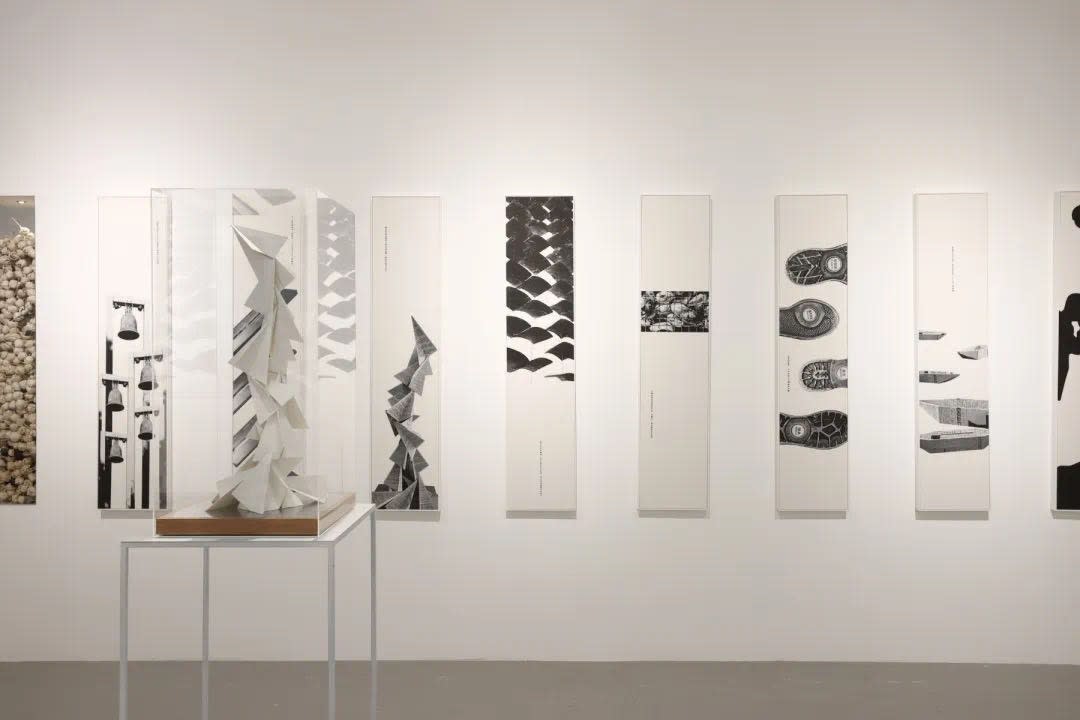
Exhibition 'Qi Shi' Installation View
Fung’s deep connection with the city has evolved within both the personal and the public domain. His role as architect working on important projects serving the public such as the Hong Kong Wetlands Park designed to preserve and research wildlife, has transformed and enriched the city and added to its development and status for both locals and visitors alike. In his artistic practice of ink painting, his emotional response to place connects him to a much longer history of Chinese cultural expression. The framing of the paintings, especially in his vertical series, allows the work to appear as a ‘row’ of windows through which we are brought into a depth of vision that is expressive and immersive, evoking a spatial dimension beyond the confines of the frame. Recalling stained-glass windows in a European cathedral or series of paintings from the Ming and Qing periods, there is a pattern of repetition with a unified theme running through it that the eye needs to make sense of as a singular visual narrative. Sliced into panels, they echo other works in the Chinese canon such as Landscapes, made up of 12 vertical scrolls by the Ming dynasty painter Lan Ying at the Hong Kong Museum of Art. In 18 Shades of Ink (2018), the sense of visual dissonance is exacerbated by the variation of imagery and there is almost a sense of blurred photography in the images of landscape that simultaneously do and do not make ‘readable’ sense, ‘a “likeness and unlikeness” effect, leaving the viewer to feel the artistic concept of a landscape with much larger scope of the imagination.’
Light, season, angle and view-point are all evoked in this series of vertical panels. In each one and then the whole, we get a sense of a vast landscape limited by our narrow view, perhaps mirroring the limit of the human eye and its range of vision, or the limits of our perceptual abilities when confronting the enormity of nature. In Morning at Hebe Haven (1994), the painting is largely made up of several large areas of ink wash in deep blue, greys, black and brown, giving way to an open patch onto the Haven that draws the eye across to the light. Almost purely abstract in its composition and structure, it is a stunning reminder of an artistic response to a specific location, experienced in the moment by the artist from a specific viewpoint on a particular day at a particular time. Yet the painting itself becomes timeless, fulfilling its cultural place as a work of its time, but also beyond time, as the depth of field produces a sense of boundless infinity.

Raymond introduces his ink paintings to audiences
The window as vista has a rich history of discussion in Western art history, used as a device for the depiction of light and psychological confinement. These paintings act as the windows themselves, opening out to vistas that directly frame the view onto a world imagined via abstract landscapes, eliminating the need for representation. The strict linear formal lines these works are held within, are offset by the moody, soaked expanses formed by the wet ink, and the spacious, active voids that surround them offer relief, completing the dynamics still extant in the world of ink painting as an interplay of solid and void, as described in the ancient classic of the Dao De Jing. Within them, depth is brought about by colour, saturations, tonality and added flecks, moving the eye from the macro-vision to the micro-vision, in a cosmic image evocative of the universe from minute invisible particles to the vast galaxies and distant planets only brought to the human eye through powerful telescopes and spacecraft in technologies used for space exploration.
The painterly description of the natural world in Fung’s paintings seems to answer to his understanding of a terrain that is viewed outside of the built environment, or even beyond it. If Chinese painting traditions have always been construed as a dialogue with the inner and outer worlds, these landscapes can also be seen as poetic interpretations, whilst hinging on certain topographical realities. Nevertheless, the painterly description in the works, whether the single works or the multiple ones presented as a unified series, arguably spans different realities – the reality of the terrain, such as the numerous islands dotted across the Hong Kong archipelago and their curvaceous bays viewed from above, or an inner mindscape describing a state of mind or feeling, in which one is immersed as one with nature.
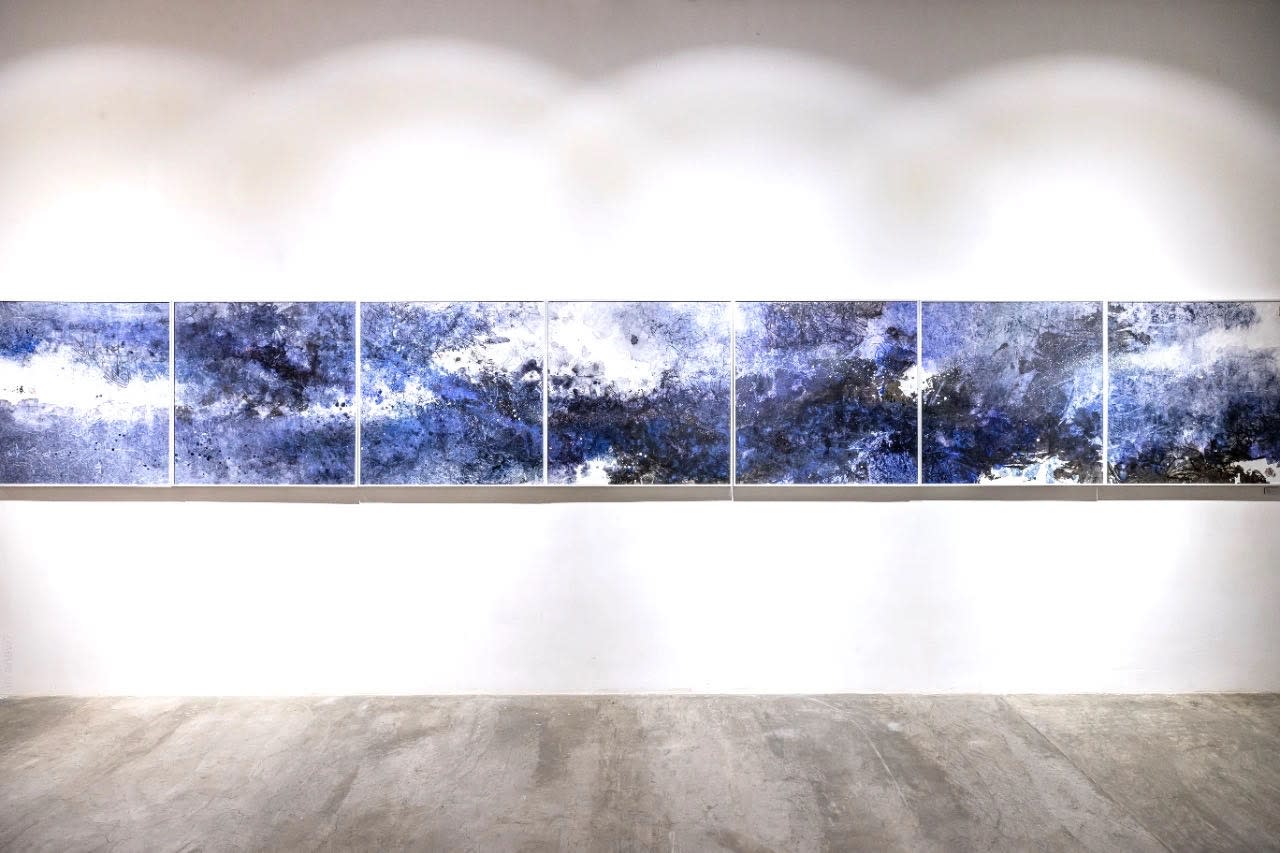
Qishi, 2022, Ink and colour on paper, 90x90cmx7(720cm)
In Hong Kong, away from the urban centre, there are numerous walking trails within its landscape allowing for elevated walks in the hills, giving panoramic vistas across the lie of the land and its bays. Paintings such as Across the Country Road (2009) - Tai Lam Chung, Ho Pui Reservoir, Tai Mo Shan, Beacon Hill, Ma On Shan, Leung Shuen Wan, Ink and colour on paper, a set of 6 horizontal scrolls measuring 26 x 193 cm, is a set of sweeping horizontal views that are Turner-esque in their ethereal qualities, yet each is a view of a specific Hong Kong location, some of which, such as the Tai Lam Chung reservoir, is indicated as a particular view of Tai Lam Chung and Ho Pui Reservoirs, seen from an elevated position and given a heightened poetic transformation in Fung’s individualistic interpretation as stunning works of emotional depth and resonance of the landscape. Fung deeply cares about the landscape, taking it in, literally and metaphorically, through his thoughtful observation and translation into the art form. Signalling a kind of ownership and connection of place, the very soul of Hong Kong is activated in these works, that go deep behind and beyond its outward appearance.
Architecture, ink and the environment
There is an intrinsic contrast in the disciplines of ink painting and architecture. One is soft, fluid, uncontrollable, expansive, unpredictable; the other is rigid, measurable and 3-dimensional. How can these two very different disciplines relate to one another and what is the relationship between them? Operating in the 2-dimensional on paper or silk, ink painting has a long, revered history that is rich with connoisseurship and scholarship spanning ten centuries or more. The idea of a contemporary ink painting contains and absorbs this history as a form of intellectual consciousness that connects it to a long lineage of philosophical engagement in the concern for man’s subjective relationship to nature and the world. Architecture also has an ancient history and has dramatically altered in the modern period, reflecting changes in lifestyle, the environment and its very function during a century of radical transformation in the aftermath of industrial revolution, technological advances and geo-political shifts following two world wars.

Exhibition 'Qi Shi' Installation View - documentaries of Raymond Fung
Fung’s architectural practice is a Western one, as he was trained in the USA, though many elements of Chinese cultural motifs are incorporated in his buildings, such as details and features on doors, interiors and the fengshui of the modern garden. In architecture, for example, vistas are designed to open up over expanses of water for psychological and aesthetic effect; in private houses designed by Fung the lines are clean, the spaces carefully designed for comfort and light and Chinese cultural features are built in for a local response to modern living spaces. More recently, his works have taken an ecological turn – titles such as Clean Water (date) mark a response to issues of pollution and environmental challenges during the growing climate crisis. In his Breathing (2020) series, the idea of breath takes a sometimes-darker turn, with a sense of oppression in the weight on the thick blackened surface, which is slightly broken up at points, in a seeming effort to break through. Underneath a dense layer of dark blue gives the appearance of a suppressed undercurrent under which something purer has been suppressed. If this is not a literal image of water, it could certainly be interpreted as a metaphor for the serious environmental challenges weighing on the world. The open void in the upper half of the image provides a stark contrast of light and dark, yin and yang. In other, larger scale works, the idea of qiyun (spirit resonance), one of the six principles of Xie He (6th century), can be discerned in expansive brushstrokes and specks dotting the space, as we become immersed in the view of a landscape and the richness within it. The eye moves across in a broad glance and is then drawn in more deeply, just as an experience of nature is both instant and cumulative, bringing deeper sensation as we stop to observe, breathe and absorb the scene.
As noted by the scholar Cordell D K Yee, in his discussion of the term qiyun, breath resonance:
‘The use of this compound dates back to at least the sixth century when the critic Xie He (fl. ca. 500-535) used it to refer to personal and representational vitality, or "breath" and harmoniousness, "resonance" of execution. By striving for qiyun, a painter could achieve the purpose of painting, "to express the spirit through form," in the words of Gu Kaizhi, a fourth-century painter. The "breath" that painters tried to express involved two senses of innerness: the innerness of the objects represented and the innerness of the painter. In aesthetic theory the two were inseparable: recognition of the innerness, the underlying essence, of external phenomena required the active perception of an artist.’

Exhibition 'Qi Shi' Installation View
Perception is also key to experiencing Fung’s works, since they cannot be immediately understood without a slower contemplation, even if they elicit an aesthetic appeal at first sight.
Fung’s paintings are formatted in traditional dimensions of the narrow scroll, both horizontally and vertically and yet, they are not hanging scrolls, since they are mounted and presented on a solid base, thereby operating between the traditional medium of ink on paper and the Western form of art that is fixed and viewed on a wall. The turn for new displays of art altered the very idea of painting in the Chinese context, when the move from the handscroll format, in which small gatherings of literati viewed temporarily in a private social context, changed to the idea of pictures on a wall decorating an interior for permanent viewing in the modern period. The experience of time is important to this idea of viewing and, as Dawn Delbanco points out, ‘this occasional viewing has everything to do with format’.
In this impressive and extensive recollection of Fung’s work over a lifetime, we are confronted with a set of works that make a significant contribution to the history of ink painting in the modern period.
They breathe resonance into our world, in a reminder of how a deep connection of place gives rise to poetic visual expression. Perhaps Fung’s oeuvre brings us closer to understanding the universe in its evocation of the known and the unknown, the real and imaginary. His recent plea for respect of nature and its preservation adds a call to arms that is more than poetic appreciation, but also a kind of painterly activism. Fung’s humility and approach to art and life is an exemplary reminder of how the seemingly ordinary can become extraordinary and a moment can become timeless. Such visual expression was understood by the reclusive fourth century poet Tao Yuanming, who stated ‘I glance over the pictures of mountains and seas. In the space of a nod, I completely [comprehend] the universe.’
